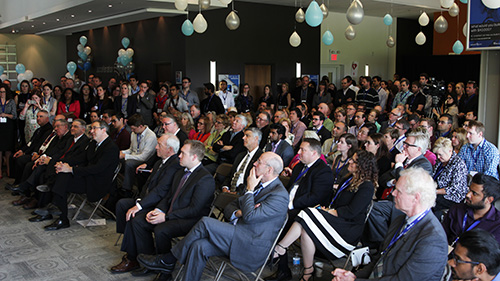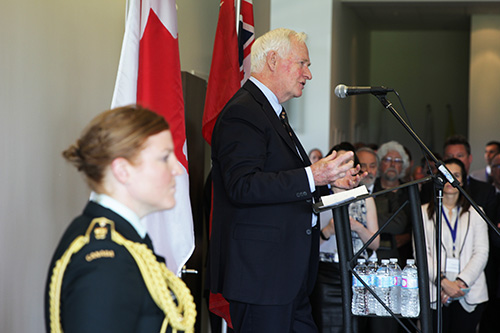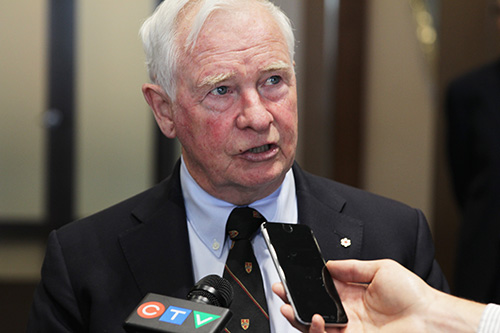When David Johnston was president of the University of Waterloo, he was famous for fielding a question: “What’s in the water in Waterloo?”
Posed by friends and colleagues from around the world, it referred to the meteoric rise of the region’s technology ecosystem during Johnston’s 11-year tenure, which ended in 2010.

Waterloo Region’s tech leaders gathered at the Accelerator Centre, listening to
Governor General David Johnston. (Communitech Photo: Phil Froklage)
Whatever is in that water, Johnston – who now occupies a national perch as Governor General – feels the rest of Canada could use a healthy dose of it. He all but said as much today at Waterloo’s Accelerator Centre, which sits in the UW research park that now bears his name.
“I want to gather the water up here in a bottle,” Johnston told reporters with a smile, “and sprinkle it all across the country.”
Johnston, whose leadership at Canada’s most innovative university helped to shape the recent history of the region, took the stage to roaring applause, as he joined a crowd to celebrate the centre’s 10th birthday. He reflected on the astonishing progress it has made in just a decade.
Clearly invigorated to be back in Waterloo – and sporting a tie carrying the UW crest – Johnston’s homecoming was also an emotional one. As he said from the stage in both of Canada’s official languages: “It’s a wonderful privilege to be here with you because I’ve come home. I’ve come home.”
Johnston used the festive occasion to remind the local tech community of its roots. They spring from a spirit of collaboration Johnston has long described as “barn raising,” in a nod to the region’s Mennonite heritage.

Governor General David Johnston celebrates the Accelerator Centre’s 10th anniversary
by sharing some of its history. (Communitech Photo: Phil Froklage)
The Governor General centred his remarks around a quote by George Bernard Shaw from Back to Methuselah, reading it aloud as he described what gives Waterloo Region its culture of innovation: “Some people see things as they are and wonder, ‘why’; we dream of things that ought to be and ask, ‘why not?’”
The answer to “why not?” is that bringing something brand new into the world is a huge amount of work, often thankless, with no map whatsoever to guide you. The only way to do it at all is with tremendous help from an entire community of people.
“This thing was not a foregone conclusion,” Johnston said, gesturing around him to the Accelerator Centre, but also the larger tech community around it. “This was not a slam dunk. This wasn’t going to happen.”
Johnston described the university’s 40-year dream to bring a research and technology park to its doorstep, and his role in the story starting in 1999, after his appointment as president. The university had been “humbled,” he said, by many setbacks as it tried to find investors for the effort. But that humility became the key to its success.
“In our humility, we said, ‘How did this university begin?’ It began with collaboration. It began with local people, with a real vision, drive, and capacity to be barn raisers, to work together with different talents. With that, we sat down with the City of Waterloo and the Region of Waterloo.
“They concluded they could use local property taxpayer dollars to invest in an academic institution. There were very, very few places – if any – in Canada or North America where you had local mayors, regional chairs and councillors saying, ‘We’re going to do this to build a brain centre in our territory.’”

Governor General David Johnston takes questions from the media at the
Accelerator Centre in Waterloo. (Communitech Photo: Phil Froklage)
Ten years on, it’s clear that building Waterloo Region into a “brain centre” – with hallmark academic institutions like UW, Wilfrid Laurier University and the Perimeter Institute for Theoretical Physics – is making an impact, as a vibrant startup ecosystem becomes an engine of economic growth.
The road from manufacturing base to knowledge economy hasn’t been easy, but the fact that the effort grew from grassroots in the local community was essential to the region’s success, a place Johnston now describes as a “remarkable leader” in Canadian science and technology. To illustrate the point, true to form, Johnston told a story:
“My wife operated a horse stable business on our farm, a Mennonite farm near Heidelberg… Insurance is something you watch very carefully. It’s hard to make this thing work on a profitable basis, so our broker said, ‘Evaluate all of your buildings to ensure you’re properly insured, but not over insured.’
“Our Mennonite neighbour Edgar, who farmed the land for us, was there as she was doing this. I said ‘Edgar, this barn here, we’ve got a value of $50,000 on it, is that right?’
“He said, ‘Why do you ask that question?’
“I said, ‘Well, it’s insured, and if it burns down we’d have to rebuild it.’
“He said ‘if it burns down, we’d rebuild it. That’s what neighbours do. And we’d bring the materials, we have our own sawmills and so on. Ah, but the asphalt tiles. We don’t make those. So, probably, put $2,000 for the asphalt tiles.’
“It’s that spirit of collaboration, and across lines, that’s so key to this area. The world needs that.”

